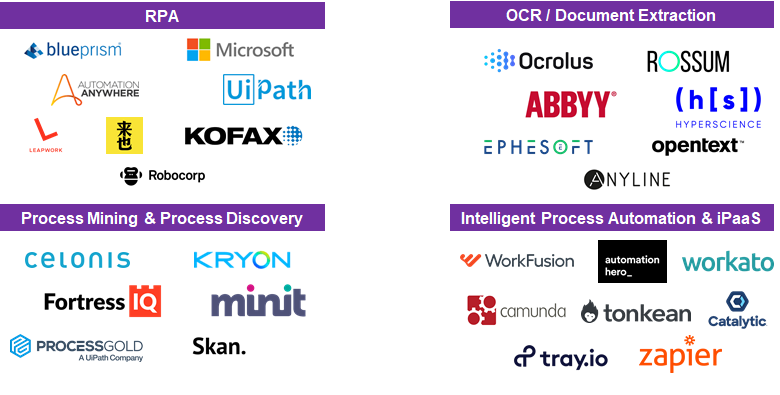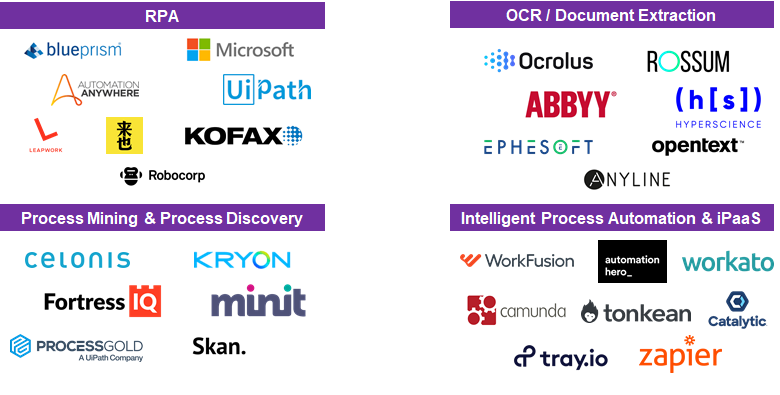From the Eyes of F500 Execs: Making Sense of the Automation Journey

January 21, 2021
Asia
By Jason Chen and Simon Wu, Cathay Innovation
In the last year, we have witnessed exciting movement in the automation software market:
- Microsoft rebranded Microsoft Flow to Power Automate, adding robotic process automation (RPA) features referred to as UI Flows. They also announced a partnership with FortressIQ to bring process discovery to Power Automate and acquired robotic process automation (RPA) vendor Softomotive.
- UiPath raised $568M at a $7B valuation last spring and acquired ProcessGold to bring process mining to Explorer Expert. More recently, they are helping healthcare systems and governments respond to COVID-19.
- Celonis raised $290M at a $2.5B valuation last fall and expanded beyond process mining by launching products that will help improve a company’s overall workflows automatically.
- Amazon announced the launch of AppFlow, allowing for greater integrations with SaaS applications.
- Laiye, Cathay Innovation portfolio company, raised $42M to continue expansion on Chinese enterprise IT.
The automation software market remains vibrant, with few signs of slowing down despite the environment under the global COVID-19 pandemic. In fact, work-from-home conditions have placed greater pressure on executives to find efficiencies throughout their business processes beyond individual tasks. Yet, with such a crowded market of products to pick from, it is unclear what the best practices are for enterprises looking to implement automation.
At Cathay Innovation, we strongly believe that collaboration among the corporations leading their industries and emerging startups is critical for the success of the wider ecosystem. This is why we spoke with a vast array of the Fortune 500 executives driving forward digital transformation within their organizations — to better understand the automation journey and better inform both corporations interested in automation and the startups selling into them. While automation can’t solve everything, having a data foundation to understand what processes need/can be improved can lead to much better results.
Below, we’d like to share the core steps and crucial lessons learned during the implementation phase along with the major trends leading corporations foresee in the products they use. We also include observations of where the automation market is today and how it’s evolving along with guidance for startups to better position themselves when selling into the enterprise in the new COVID environment.
The Automation Journey
We frequently have discussions with our corporate ecosystem, and more recently, our conversations have centered around their respective “automation journey.”
While several executives stated that their “automation journey” took a few years for teams to adopt new automation technologies, others have accelerated their consumption in automation and made adjustments with their back-end infrastructure to increase agility.
Successful corporations start with concrete problems and use cases where automation can be implemented (Stage 1). One of the first challenges is understanding the required form of automation to solve the specific use case or business process. Corporate executives advise:
- Focus on the long-term objectives of each business process and the entire chain of command, rather than on individual tasks.
- Start with business processes that are less complex yet highly strategic to build early success internally and externally. Do not be discouraged by underwhelming results, as it is an iterative process.
- Align the strategy between management and employees, as many employees do fear replacement. With both parties aligned, identifying bottlenecks and overall productivity improves.
- Security. Security. Security. Establish governance and work closely with IT during the deployment phases to reduce the long-term risks of an increased surface area.
Most corporations we spoke to have selected either UiPath or Automation Anywhere for RPA. During deployment (Stage 2), we find that most enterprises start with back-office functions, mainly in finance and supply chain. Business processes within these two departments are complicated, requiring input from multiple departments in both structured data (from Salesforce, ServiceNow, SAP, Oracle, Excel, etc.) and unstructured data formats (email, pdfs, hand-written notes, etc.). Therefore, many choose to start by automating individual repetitive tasks and simple workflows that mainly work with structured data formats.
As users gain confidence in RPA (Stage 3), several corporations expand their usage by deploying more RPA in increasingly complex workflows and adopt additional tools. These may include business process management (BPM) platforms with a built-in integration platform as a service (iPaaS), optical character recognition (OCR) tools, or conversational chatbots. It’s important to recognize the limitations of RPA and the growing value in outside solutions. For example, one of the most significant constraints to RPA is that the technology does not work well with unstructured data today.
Through this journey, enterprises begin to take a different perspective on their automation strategy and solidify best practices for future deployments (Stage 4). Some revisit their existing internal processes, generally with the help of a process mining or discovery tool. With better visibility in their internal workflows, executives can evaluate the necessity of the RPA already deployed and the potential need to re-engineer or redesign the process. A couple of trends we have seen with corporates at this stage are shifts in focus towards:
- Purchasing end-to-end (E2E) business process verification and orchestration platforms to highlight potential bottlenecks and to empower end-users to design processes with modules powered by machine learning or Natural Language Processing (NLP). Of note, several organizations saw significant improvements in the ML/AI capabilities on unstructured data formats.
- Leveraging process mining tools as the management layer for both work and automation. Executives are starting to understand that automation is not always necessary in certain processes and that bottlenecks can be resolved through other means such as a redesign in workflow, retraining of employees, or modifications to the system.
-
Increasing architecture flexibility to enable API driven processes and improve overall agility. Of note, most organizations do recognize that this will likely take much longer.
Market Evolution of Automation Platforms
We expect automation vendors to evolve as more enterprises move further into their automation journey. As mentioned, several significant vendors are making strategic acquisitions and product developments to better serve their customer needs. There is a plethora of horizontal and best-of-breed solutions. Executives recommend using both types of tools.

Moving forward, there will be a greater focus on process mining and intelligent process automation platforms, as well as a growing influence of vertically specific automation tools.
Given that every automation journey starts with understanding existing internal workflows, we expect process mining to be increasingly used as the verification layer in analyzing workflows. Historically, many companies leveraged consultants and log-based process mining tools to visually digitize their workflows. Recently, computer vision has been leveraged to augment traditional methods to provide greater accuracy. Thus, process mining can empower users to better decide where to implement automation software, redesign their processes, and/or increase employee training.
Intelligent business process automation platforms can empower enterprises to consolidate the tools they use for automation and create the E2E workflows they desire. These are especially helpful as most business processes include a combination of human intervention and data manipulation with complex workflows consisting of numerous data formats and applications. Thus, we expect to see more solutions that combine the modules of a workflow engine, iPaaS, and OCR.
Lastly, we have seen increased momentum in automation software that is vertically or departmentally focused, for example through companies that provide automation in IT, customer service, and finance departments. Our corporate executives have shared that these sets of products can contextualize data and provide higher accuracy in automation or responses. Additionally, the customized workflows are easier to use than horizontal solutions where an end-user may have to start from scratch. In the near term, however, we still anticipate that enterprises will balance both horizontal and best-of-breed tools.
What Startups Entering the Market Need to Consider
So, what does this all mean for startups selling to the enterprise in the current COVID environment?
Enterprises are still very much open to adopting new technologies. However, sales representatives should be clear on the problem at hand and the appropriate type of automation. Sales representatives can then quickly identify whether the prospect is a qualified lead to set priorities within their startup’s pipeline. We repeatedly observe startups pushing products that don’t necessarily address the company’s current needs, as some believe that all forms of automation can solve every type of bottleneck. This misconception is especially common with products that provide E2E solutions, where we have seen cases of iPaaS products looking to solve an RPA problem.
Timing is crucial. Some enterprises may not need an intelligent process automation platform, but that may become a need in the future. When sales representatives understand where an enterprise is in the automation journey, they can improve their sales pitch and think creatively about near-term use cases. The automation journey is quite broad and having clarity on the stage of an enterprises’ RPA deployment or the status in the development of their automation team, will give sales reps better context on the tools they likely already tested or would be open to testing.
Security. Security. Security. Understanding the security needs or concerns early in the process will de-risk the possibility of procurement into holding up a sale. Several corporate executives we spoke to have terminated successful automation projects due to security concerns. Startups should gauge how comfortable the prospect is with a cloud-native solution or a hybrid solution.
Although sales cycles are lengthening, it can be more efficient by better understanding the stage of the automation journey that an enterprise is in.
Concluding Thoughts
As we continue to progress through COVID-19, it will be interesting to see not only the different paths enterprises take in digitizing their business processes but also how quickly they modernize their back-end infrastructure. With more modern architecture, some of these automation tools may become less relevant. While some corporate executives would argue it is easier said than done, we may already be witnessing that change in architecture as we speak. As Satya Nadella, CEO of Microsoft, observes, “As COVID-19 impacts every aspect of our work and life, we have seen two years’ worth of digital transformation in two months.”
Special thanks to Angela Liang, Albert Koh, Chris Yin, and Danny Crichton for reviewing multiple drafts of this post.